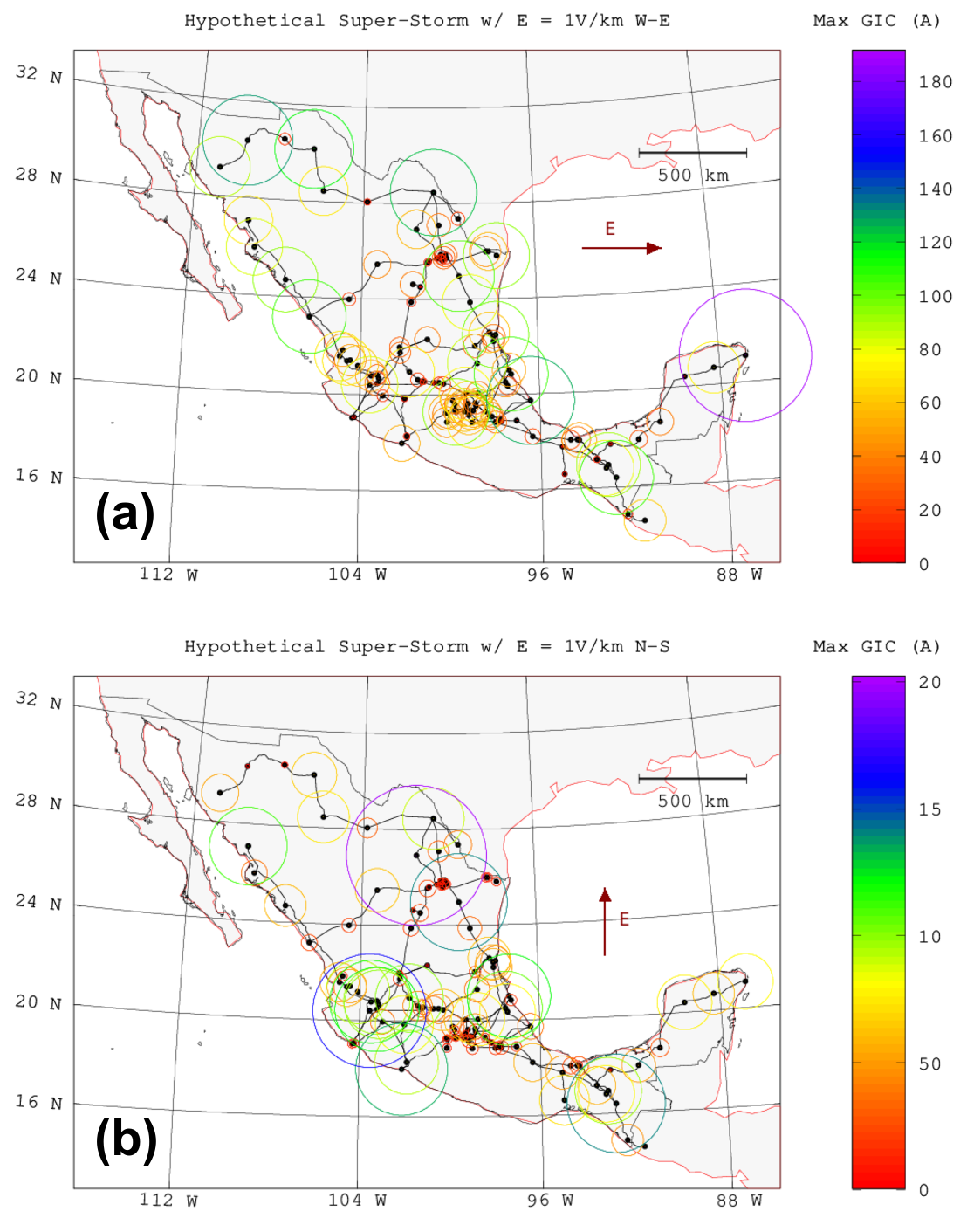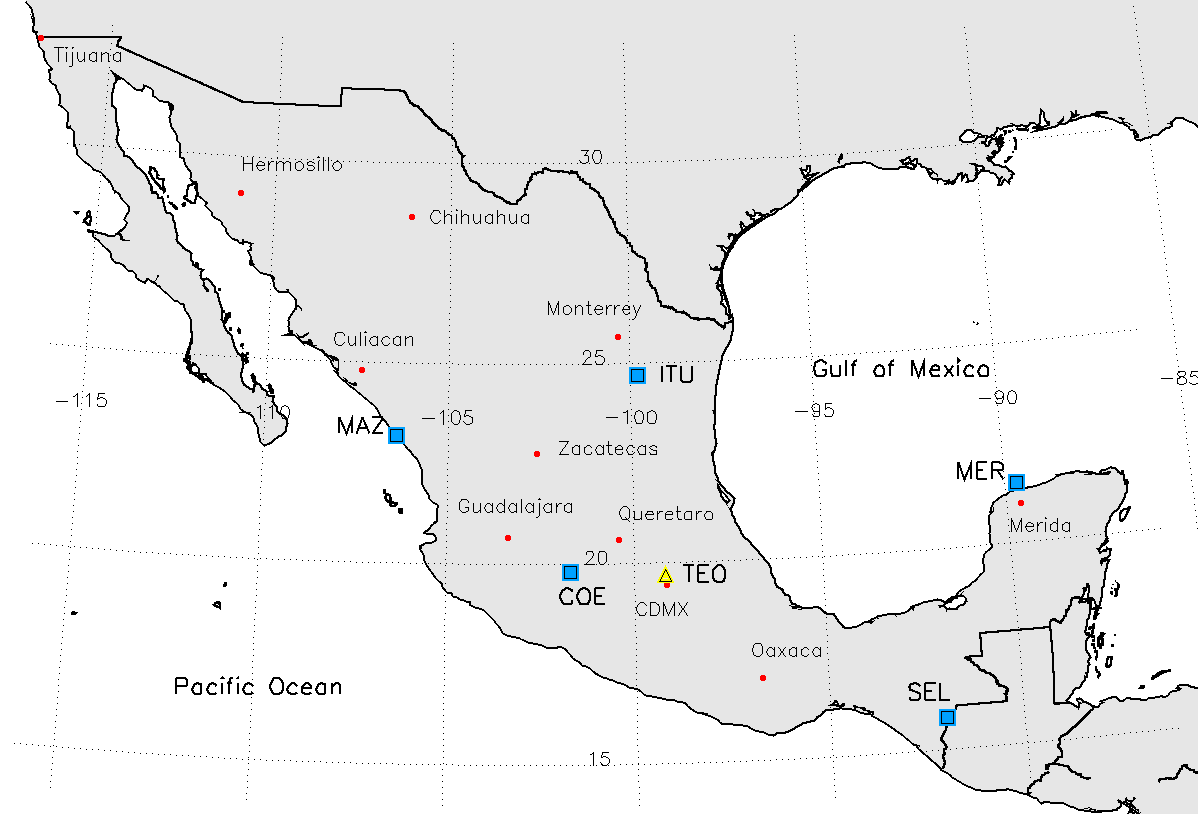The Regmex Array
Geomagnetic Stations Network of Mexico

About REGMEX array
The Geomagneitc Station Network of Mexico or REGMEX (from Spanish spelling) is a Space Weather National Laboratory (LANCE) project that aims to provide useful information for the protection of infrastructure, technology and services susceptible to the effects of geomagnetic storms (GMSs).
REGMEX will be a trigger for technological development and innovation, and the resulting database will promote the development of new technologies and innovation. In addition, our datasets will promote scientific and technicalstudies, as well as national and international collaborations.
For this purpose, REGMEX team works to:
- Develop, operate and maintain infrastructure and instrumentation to record, in real time, the geomagnetic field in Mexico.
- Develop the technology to store and process the geomagnetic field in Mexico records, in near-real time.
- Monitor the Space Weather in Mexico by means of regional geomagnetic indices, in near-real time.
- Develop, innovate and distribute products dedicated to characterize and monitor the magnetic field in Mexico.
Additionally, our database is free and open to encourage scientific and technical studies and collaborations. See our Data Policy for further details.
REGMEX Background
Space Weather (SW) studies the manifestations and effects that solar activity has on the Earth system. This includes the repercussions they may have on infrastructure, technology, human health and other areas yet to be investigated. One of the high-risk SW events are geomagnetic storms (GSs). These are planetary-scale alterations of the Earth's magnetic field lasting hours or days. It is considered that an extreme GS could cause a planetary-scale catastrophe, disabling or significantly limiting essential technologies and services in vast regions for weeks or months. This makes GSs a natural hazard that requires management from the highest levels. [Echer et al., 2005; Schrijver et al., 2015]
Due to the heterogeneity of the Earth and the anisotropies in the ionospheric and magnetospheric currents, GSs manifest themselves differently in each region of our planet, and thus the effects of TGs on susceptible technologies and infrastructures will also depend on each region. Therefore, in order to carry out effective risk management due to TGs, it is essential to have, at a regional level, instrumentation dedicated to monitoring, detecting and recording these phenomena.
Geomagnetically Induced Currents (GICs) are a consequence of TGs. GICs can cause overloads in high voltage electrical distribution networks, causing damage ranging from a reduction in the useful life of their components to the disabling of the electrical service. In extreme cases, GICs can disable power transformers, leaving large regions without electricity, as in the case of Quebec, Canada, in 1989, causing significant economic losses and putting the population at risk. It is important to note that these effects are substantially accentuated in large urban centers. [see Boteler, 2019]
Systematic studies of SW in Mexico began with the launch of the Space Weather Service of Mexico (SCIESMEX, in 2014) and the National Space Weather Laboratory (LANCE, in 2016), both at the Institute of Geophysics of the UNAM. These studies have provided solid evidence of the effects of SW on facilities, infrastructures and services in Mexico that could represent risks to national security [e.g. Gonzalez-Esparza etal., 2018; Gonzalez-Esparza etal., 2024].
The General Civil Protection Law considers extreme events of the SW as threats to National Security (Art. 2, paragraphs XVI and XXI). Therefore, the Mexican government has the responsibility to address the risks and develop public policies (reaction plans) to these phenomena (Art. 20). In this sense, it is essential to have a network of instruments that assist the authorities in their management tasks aimed at safeguarding national security against the effects of intense GSs.
In this context, the development of infrastructure to monitor GMSs is essential. Which is one of the main objectives of REGMEX array.
Risk due to Geomagnetic Storms in Mexico
Systematic studies of the risk and vulnerability to GSs in Mexico are recent and scarce. R. Caraballo et al. [2020] performed simulations of the effects of significantly intense GSs on the Mexican electricity distribution network. Figure 1 shows two results of the simulations performed by R. Caraballo et al. [2020] for two cases of the electric field associated with TG. This work found that, under certain conditions, CIGs greater than 120 A can occur in some substations of the high-voltage electricity distribution network in Mexico.
Studies of risk and vulnerability to GSs and GICs in Mexico are recent and scarce. In the specialized literature we have the works of Ramón Caraballo and collaborators [2020 and 2023]. These works investigated the intensity of GICs in the national high-power electrical grid caused by intense GMS and concluded that Mexico's high voltage transmission network is affected even during moderate geomagnetic disturbances. These works found out that, under certain conditions, CIGs greater than 120 A can occur in some substations of the high-voltage electricity distribution network in Mexico.

The figure summarizes the most relevant results obtained in Caraballo et. to the. (2020). We note that the ends of the network (black solid lines) oriented to the induced electric field (cherry-color arrow) tend to be the most vulnerable regions (circles with larger radii). According to this study, the following are identified as vulnerable regions:
- Yucatán-Quintana Roo,
- Veracruz,
- Chiapas-Oaxaca
- Coahuila-Nuevo León,
- Sinaloa,
- Sonora-Chihuahua,
- Jalisco and and Michocacán.
Besides GICs, GSs are also associated with disturbances in the Earth's ionosphere. These disturbances can affect different technological systems, degrading or interrupting the services they provide. Some of the systems potentially at risk include positioning and navigation services (air, land and maritime), telecommunications, radio communications, internet, satellite services, financial services, among others. [Schrijver etal., 2015]
Mexico is a country that is constantly at risk from a variety of natural hazards. In general terms, the Mexican population is accustomed to living with earthquakes, hurricanes, and even volcanic activity. To these three natural phenomena, by mandate of law and empirical evidence, Space Weather must be added as a source of risk. For this reason, it is essential to have a network of instruments dedicated to monitor the state of the Space Weather, particularly its effects on the geomagnetic field.
REGMEX Project
Because of the commented on before, the REGMEX project's primary objective is the real-time recording/monitoring of the geomagnetic field in regions identified as being at risk for Space Weather events. To this end, we contemplate the development of a network of geomagnetic stations (GMS) distributed throughout the continental territory of Mexico. At the right side of this page, we list the links ot our GMS.

The figure shows the planified final state of REGMEX array. Once completed, the REGMEX array will consist of at least 5 stations (blue squares in the figure) that will monitoring in near real-time the magnetic field of most of the mexican territory. Our instrumentation will be supported by an autonomous data management system that will assure public data-access in near real-time to regional geomagnetic products an registers.
In addition, REGMEX array will support other activities and products that includes:
- Study the influence of geomagnetically induced currents.
- Assist in subsoil conductivity studies and other types of geophysical and geological studies that may apply.
- Provide high-quality data (geomagnetic records) for the development of scientific research.
Instrumentation
REGMEX/LANCE has five triaxial magnetometers (variometers) whose sensor is a Bartington flux-gate model M-103. These magnetometers were acquired at the Jicamarca Radio Observatory (Peru).
Our partners from Institute of Geociences have four LEMI magnetometers. Whereas our Magnetic Service colleages have an Overhauser POS N129 magnetometer by Quantum Magnetometry Laboratory.
